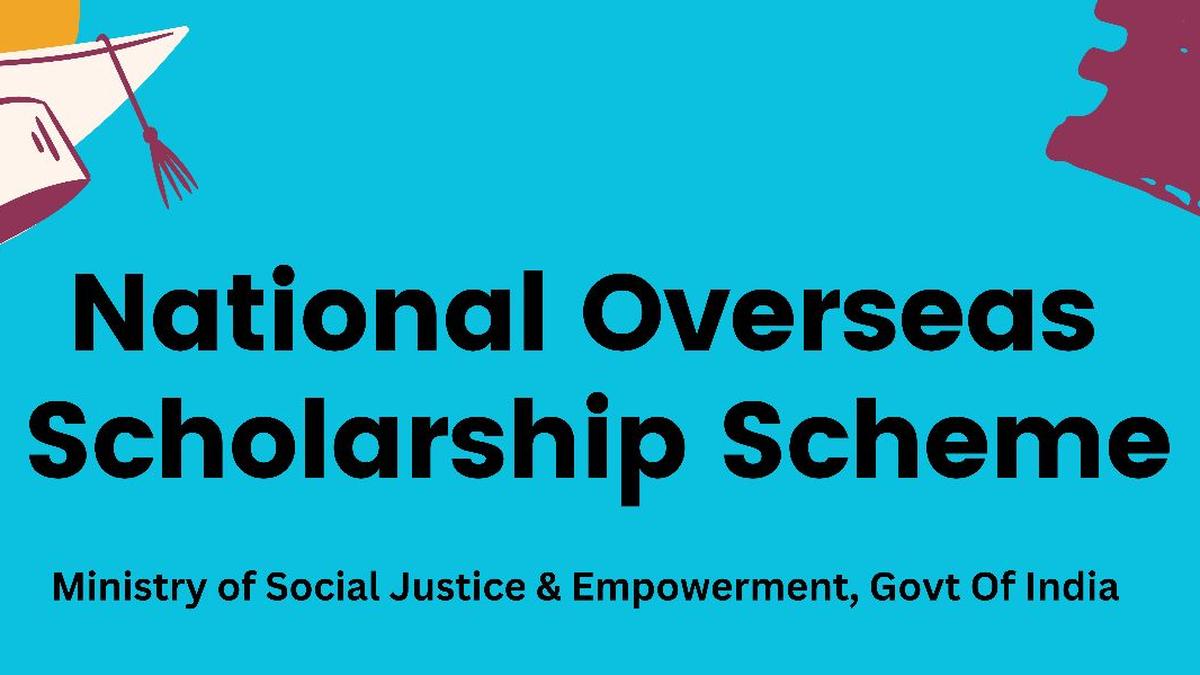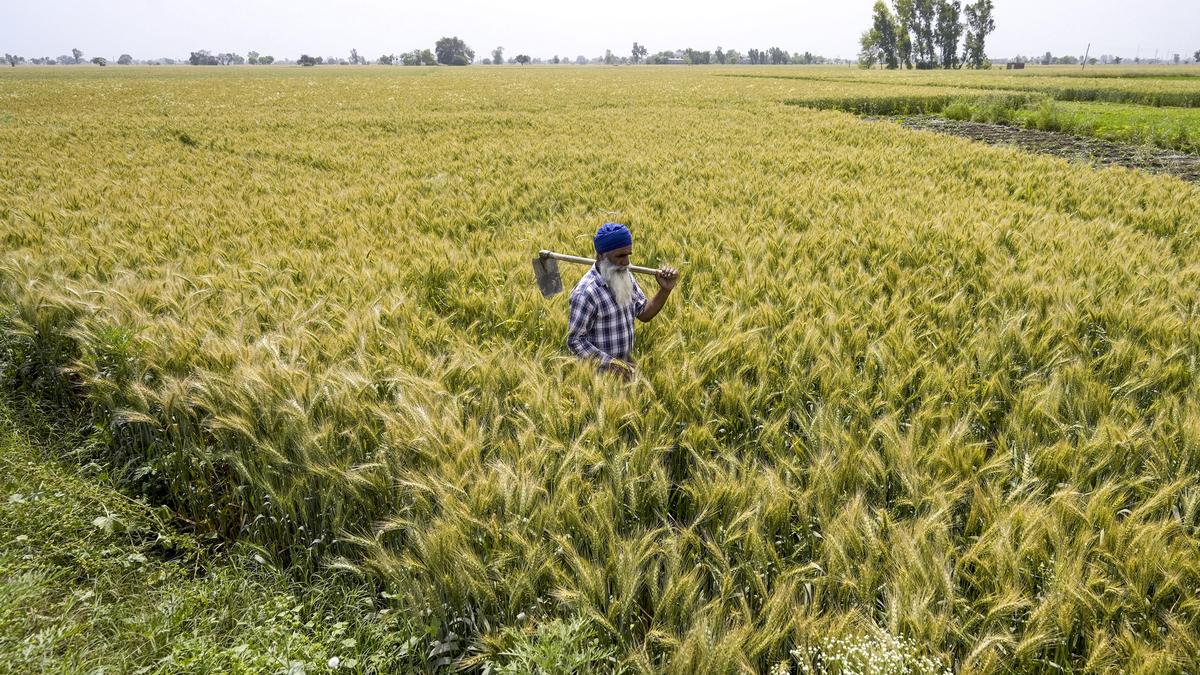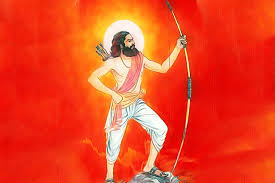National Overseas Scholarship Scheme

- 09 Jul 2025
In News:
The Ministry of Social Justice and Empowerment has come under scrutiny after withholding provisional award letters for 66 out of 106 selected candidates under the National Overseas Scholarship (NOS) scheme for the 2025–26 cycle. This development has raised concerns regarding funding gaps, administrative bottlenecks, and the future of the scheme intended to uplift marginalised students through access to global education.
About the National Overseas Scholarship Scheme
- The NOS is a Central Sector Scheme aimed at enabling students from socially and economically disadvantaged communities to pursue postgraduate (Master’s) and doctoral (Ph.D.) education abroad in top-ranking universities.
- It provides financial assistance for tuition, living expenses, contingency costs, and travel.
- Administered by: Ministry of Social Justice and Empowerment
- Target Beneficiaries:
- Scheduled Castes (SCs)
- Denotified, Nomadic, and Semi-Nomadic Tribes
- Landless Agricultural Labourers
- Traditional Artisans
- Eligibility Criteria:
- Academic Qualification:
- Master’s: Bachelor’s degree with ≥ 60%
- Ph.D.: Master’s degree with ≥ 60%
- Age Limit: Not more than 35 years as on April 1 of the selection year.
- Income Limit: Annual family income should not exceed ?8 lakh.
- University Criteria: Unconditional admission in Top 500 QS-ranked institutions.
- Other Conditions:
- A maximum of 2 students per family (second eligible only if slots remain).
- Not already settled or studying abroad.
- Key Features:
- Total Annual Slots: 125
- 115 for SCs, 6 for Denotified Tribes, 4 for Labourers/Artisans
- 30% reserved for women candidates
- Two-Phase Selection:
- First: QS Top 500 mandatory
- Second: Open to broader university lists
- State Cap: Maximum 10% slots per state to ensure geographic diversity
Ongoing Evaluation and Policy Review
- The government is currently conducting a performance evaluation of the NOS scheme ahead of its 16th financial cycle (2026–27). This includes assessing issues related to fund disbursal, slot utilization, and implementation gaps.
- A Parliamentary Standing Committee on Social Justice and Empowerment had earlier flagged:
- Insufficient scholarship amounts
- Persistent delays in fund release
- Underutilization of slots
- Need for expanding coverage and increasing annual slots
17th BRICS Summit 2025
- 09 Jul 2025
In News:
The 17th BRICS Summit was held in Rio de Janeiro, Brazil under the theme:
“Strengthening Global South Cooperation for a More Inclusive and Sustainable Governance.”
The summit concluded with the adoption of the Rio de Janeiro Declaration, marking a strategic shift towards BRICS expansion, inclusive multilateralism, and South-South cooperation.
What is BRICS?
- BRICS is an intergovernmental platform of emerging economies originally comprising Brazil, Russia, India, China, and South Africa.
- The term BRIC was coined by economist Jim O’Neill in 2001.
- The grouping evolved from informal dialogue (1st Summit in 2009, Yekaterinburg) to a structured cooperation framework.
- In 2024–25, BRICS underwent expansion and is now referred to as BRICS+.
Key Highlights of the 17th BRICS Summit 2025
1. Expansion of Membership
- Indonesia formally joined BRICS in 2025, becoming its first Southeast Asian member.
- Eleven new BRICS+ partner countries were welcomed: Belarus, Bolivia, Kazakhstan, Cuba, Nigeria, Malaysia, Thailand, Vietnam, Uganda, Uzbekistan.
- The expansion aims to reshape global power dynamics, promote multipolarity, and deepen Asia-Africa-Latin America cooperation.
2. Rio de Janeiro Declaration: Major Themes
A. Global Governance Reform
- Strong call for reforming UNSC, IMF, WTO to reflect contemporary geopolitical and economic realities.
- Supported the UN Summit of the Future's “Pact for the Future”, including the Global Digital Compact and Declaration on Future Generations.
- Emphasized greater participation of the Global South in international decision-making.
B. Peace and Security
- Condemned terrorism in all forms; specifically denounced the Pahalgam attack in India.
- Called for zero tolerance for terrorism and decisive global action against sponsors of terror.
- Opposed securitizing climate change; advocated development-centric responses to global challenges.
C. Technology and Responsible AI
- Released a Statement on Global AI Governance promoting a balance between innovation and regulation.
- Proposed the creation of a BRICS Science & Research Repository to facilitate open access for Global South researchers.
D. Climate Action
- Reaffirmed commitment to the Paris Agreement and UNFCCC principles, especially Common But Differentiated Responsibilities (CBDR).
- Supported Brazil’s hosting of COP-30 (Belem) and endorsed India’s bid for COP-33 in 2028.
- Launched the BRICS Leaders’ Framework on Climate Finance to enhance climate adaptation and finance equity.
E. Economic and Financial Cooperation
- Reviewed the BRICS Economic Partnership Strategy 2025; agreed to frame the 2030 Strategy, focusing on:
- Digital economy
- Trade and investment
- Financial integration
- Sustainable development
- Emphasized inclusive, rules-based multilateral trade systems.
- Launched BRICS Multilateral Guarantee Mechanism (BMG) under New Development Bank (NDB) to catalyze infrastructure and climate finance.
F. Social and Cultural Priorities
- Focus on inclusive development through:
- Empowerment of youth and women
- Support for persons with disabilities
- Urbanization and migration management
- Recognized demographic transitions as opportunities for sustainable growth.
India at BRICS 2025
India played a pivotal role in shaping key summit outcomes and announced its BRICS Chairship for 2026, themed around: Building, Resilience, Innovation, Cooperation, and Sustainability.
India’s Key Interventions:
- Global Financial Reform: Advocated for de-dollarization and diversification of global trade currencies.
- Digital Governance: Pushed for interoperable, inclusive digital public infrastructure.
- Institutional Reform: Reiterated the urgent need to restructure global governance institutions.
- Climate Finance: Urged equitable climate financing mechanisms for developing nations.
On BRICS Currency:
- India rejected the idea of a common BRICS currency, but supported local currency trade under a National Currency Settlement Framework.
- Refused to settle Russian oil trade in Chinese Yuan, indicating resistance to Chinese monetary dominance within BRICS.
Geopolitical Implications and U.S. Response
- With BRICS now representing 45% of the global population and 35% of world GDP, the bloc's rise has triggered concern in Western circles.
- The U.S., under former President Donald Trump, warned of:
- 10% tariff on countries aligning with BRICS’ "anti-American" stances.
- 100% tariff if BRICS pursues de-dollarization, viewing it as a direct challenge to U.S. economic interests.
Discovery of Penico
- 09 Jul 2025
In News:
Archaeologists have recently uncovered a significant archaeological site in northern Peru—an ancient city named Penico, estimated to be around 3,500 years old. The discovery sheds new light on early urban development, trade networks, and cultural evolution in pre-Inca South America.
Location and Time Period
- Geographic Location: Penico is located in the Barranca Province of northern Peru, approximately 200 km north of Lima, the capital.
- Altitude: The site is situated on a hillside terrace, around 600 metres above sea level.
- Estimated Age: The city is believed to have been founded between 1800 BCE and 1500 BCE, roughly during the same period as early civilizations in Egypt, Sumeria, and the Indus Valley.
Key Features of the Site
Urban and Architectural Highlights:
- The city is laid out around a central circular plaza, encircled by at least 18 identified stone-and-mud structures.
- Structures include:
- Ceremonial temples
- Residential complexes
- Public gathering areas with sculpted wall reliefs
Notable Artifacts:
- Clay figurines depicting human and animal forms
- Pututus (conch shell trumpets), traditionally used for long-distance communication
- Beaded necklaces and ceremonial artifacts crafted from shells and stones
Cultural and Historical Significance
Strategic Importance:
- Penico’s elevated location likely served both practical and symbolic purposes—protecting against natural disasters such as floods or landslides, while also enhancing the visibility and monumentality of its structures.
- The city’s placement made it a vital trading nexus, linking communities across the Pacific coast, Andean highlands, and the Amazon basin.
Link to the Caral Civilization:
- Penico is situated near the ancient city of Caral, considered the oldest known civilization in the Americas (dating back to 3000 BCE in the Supe Valley).
- Researchers suggest that Penico represents a cultural continuation or evolution of the Caral society, which declined due to climatic disruptions.
- The discovery of Penico offers valuable insight into how civilizations adapted and transitioned post-Caral, particularly in terms of urban planning, trade, and ceremonial practices.
Comparative Civilizational Context:
- Despite emerging in geographic isolation, Penico developed contemporaneously with Bronze Age civilizations of Mesopotamia, the Nile Valley, and South Asia, showcasing parallel patterns in complex societal development.
International Treaty on Plant Genetic Resources for Food and Agriculture (ITPGRFA)

- 09 Jul 2025
In News:
India has raised strong objections to proposed amendments to the International Treaty on Plant Genetic Resources for Food and Agriculture (ITPGRFA)—also known as the Plant Treaty—during recent deliberations in Peru. The concerns stem from potential implications for India’s sovereign rights over plant genetic resources and its traditional farming practices.
About the Plant Treaty
The Plant Treaty is a legally binding international agreement, adopted by the Food and Agriculture Organization (FAO) in 2001 and enforced from 2004. India is a signatory to the treaty. It is aligned with the Convention on Biological Diversity (CBD) and supports the FAO’s Global Plan of Action.
Key Objectives:
- Conservation and sustainable use of plant genetic resources for food and agriculture (PGRFA).
- Equitable sharing of benefits arising from the use of these resources.
- Ensuring food security and preserving agrobiodiversity, especially for climate-resilient agriculture.
Core Features of the Treaty
- Multilateral System (MLS) of Access and Benefit-Sharing:
- Covers 64 major crops (e.g., rice, wheat, maize, pulses) listed in Annex I.
- Facilitates global access to plant genetic materials among member nations.
- Ensures benefit-sharing through:
- Technology transfer
- Capacity-building
- Commercialization revenues
- Standard Material Transfer Agreement (SMTA):
- A legal framework that governs the access, transfer, and exchange of genetic materials under the MLS.
- Farmers' Rights (Article 9):
- Recognizes the rights of farmers to save, use, exchange, and sell farm-saved seeds.
- Acknowledges indigenous knowledge and the contributions of local communities.
- Encourages inclusion of farmers in decision-making processes.
- Global Information System (Article 17): Facilitates data-sharing on plant genetic resources globally.
- Benefit-sharing Fund (BSF): Supports farmers and public institutions in developing countries to conserve genetic diversity, enhance crop productivity, and build resilience to pests and climate change.
India’s Concerns Over the Proposed Amendments
The new proposal seeks to expand the scope of Annex I, making it mandatory for countries to share all plant germplasm through the MLS under a uniform SMTA framework.
Why India Opposes the Proposal:
- Erosion of Sovereignty: It may weaken India’s control over its vast indigenous plant genetic wealth.
- Legal Conflict: The proposal could override India’s national laws governing access and benefit-sharing.
- Impact on Traditional Practices: Smallholder and tribal farmers who rely on traditional seed-saving and exchange systems may be adversely affected.
- Threat to Biodiversity Conservation: Centralized control over plant genetic materials could hinder community-led conservation efforts.
Alluri Sitarama Raju

- 09 Jul 2025
In News:
During the 128th birth anniversary celebration of Alluri Sitarama Raju, the Union Defence Minister lauded his valiant role in India’s freedom movement. The Minister also reiterated the government’s commitment to ending Maoist extremism by August 2026.
Alluri Sitarama Raju
- He was a revolutionary figure revered for leading a tribal resistance against British colonial authority. Although he did not belong to a tribal community himself, he championed the cause of indigenous people, earning their deep respect and admiration.
- He was born on 4 July 1897 in Mogallu village, near Bhimavaram, located in present-day Andhra Pradesh. His revolutionary activities were concentrated in the Eastern Ghats’ Agency areas of the state.
Historical Context
- Early Life and Spiritual Turn: After receiving basic education in his village and later in Visakhapatnam, Alluri chose a life of renunciation around the age of 18. As a sanyasi, he traversed forested and hilly regions, developing a close bond with tribal communities.
- Gandhian Influence and Shift to Armed Struggle: Initially influenced by Mahatma Gandhi’s Non-Cooperation Movement, he urged tribal people to disengage from colonial institutions. However, disillusioned by the ineffectiveness of non-violence in protecting tribal rights, he resorted to armed rebellion.
- Role in the Freedom Struggle
- The Rampa Rebellion (1922–1924): Alluri became the face of the Rampa Rebellion, launched in protest against the Madras Forest Act, 1882, which curtailed traditional tribal practices like Podu cultivation and led to forced displacement. Additionally, tribals were subjected to unpaid labour for constructing colonial infrastructure, fueling widespread anger.
- Guerrilla Tactics and Resistance: Raju organized tribal youth into a guerrilla army that attacked British police outposts, looted weapons, and eliminated British officers, causing considerable concern for the colonial administration.
- Martyrdom: His growing influence and success made him a prime target for the British, who announced a ?10,000 bounty for his capture. He was eventually apprehended through deception and executed on 7 May 1924, reportedly tied to a tree and shot dead.
Legacy
- Revered as “Manyam Veerudu” or the Hero of the Jungle, Alluri’s life epitomizes courage and sacrifice.
- The Government of Andhra Pradesh commemorates July 4 as a state festival in his honour.
- He remains a powerful symbol of tribal resistance and justice in India's freedom narrative.
